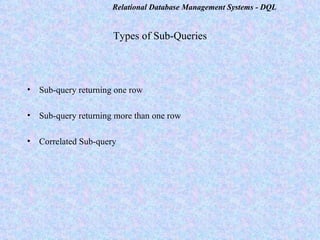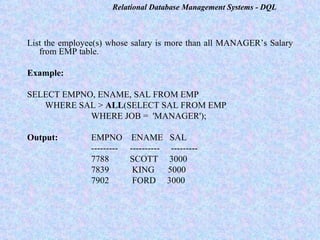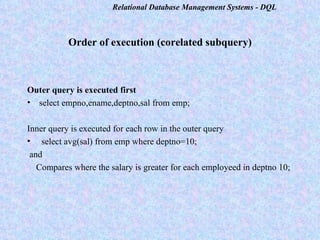Sql query [select, sub] 4
- 1. DQL [Data Query Language]
- 2. Syntax for SELECT statement: SELECT <COLUMN-LIST> FROM <TABLE-NAME> [WHERE <CONDITION>] GROUP BY <COLUMN-NAME(S)>] [HAVING <CONDITION>] [ORDER BY <EXPRESSION>]; Example: Select * from EMP;
- 3. Selecting one or more columns from the table It is possible to select only few columns from the table. To list employee number, employee name, job and salary from EMP table, the following query to be given. Example: SELECT EMPNO, ENAME, SAL, JOB FROM EMP; It is not necessary for the column(s) in the SELECT statement, to be in the same order of the table.
- 4. Changing Column names using Aliases To distinguish the real column name with a more meaning full name for better understanding while displaying the results then, an alias can be used after that column name. In EMP table the column MGR stands for MANAGER. To display MGR column as MANAGER the query can be written using alias as follows: SQL> SELECT EMPNO, ENAME, MGR "MANAGER" FROM EMP;
- 5. WHERE Clause Conditional retrieval of rows using WHERE clause Example: SELECT * FROM EMP WHERE DEPTNO = 10; WHERE clause filters the EMP table with DEPTNO = 10 alone. Oracle checks the DEPTNO column in each row for an entry as 10, if found then it sends them as output else skips the rows which does not match the condition. The WHERE clause in the SELECT statement can have Relational, Logical, Arithmetic and String Operators. Example 1: SELECT * FROM EMP WHERE ENAME = ‘SMITH’;
- 6. Working with NULL values NULL values are not 0 or blank. It represents an unknown or inapplicable value It cannot be compared using the relational and/or logical operators. The special operator ‘IS’ is used with the keyword ‘NULL’ to locate NULL values. Examples: SELECT ENAME FROM EMP WHERE COMM IS NULL ; (The above command will list the employee(s) who is not getting commission).
- 7. Order by Clause Displaying the results in a sorted order SQL uses the ORDER BY clause to impose an order on the result of a query. ORDER BY clause is used with SELECT statement. One or more columns and/or expressions can be specified in ORDER BY clause. The ORDER BY clause sorts the query output according to the values in one or more selected columns. Multiple columns are ordered one with another, and the user can specify whether to order them in ascending or descending order. Ascending is default .
- 8. Syntax: SELECT <COLUMNS> FROM <TABLE-NAME> ORDER BY [<COLUMN-NAME>, <COLUMN-NAME>] ASC/DESC; Example 1: SELECT * FROM EMP ORDER BY ENAME; (The above command will list all the employees from EMP table in ascending order of employee name) Example 2: SELECT EMPNO, ENAME, DEPTNO, SAL FROM EMP ORDER BY DEPTNO; (The above command will list all the employees from EMP table in ascending order of Department number) Example 3: SELECT EMPNO, ENAME, HIREDATE EMP ORDER BY HIREDATE DESC; (The above command will list all the employees from EMP table in descending of hiredate).
- 9. Sorting the result on multiple columns To sort DEPTNO of EMP table in ascending order and then to further sort salary in each department in descending order, the following example query can be issued. Example: SELECT EMPNO, ENAME, DEPTNO, SAL FROM EMP ORDER BY DEPTNO, SAL DESC;
- 10. GROUP BY clause ORDER BY acts upon rows whereas GROUP BY acts upon groups. Example: SELECT MAX(SAL), MIN(SAL), AVG(SAL), COUNT(*), SUM(SAL) FROM EMP; Output: MAX(SAL) MIN(SAL) AVG(SAL) COUNT(*) SUM(SAL) ------------- -------------- ------------- ------------- ------------- 5000 800 2073.2143 14 29025
- 11. To find the maximum of salary for department 10, then the query has to be: SQL > SELECT MAX(SAL) FROM EMP WHERE DEPTNO = 10; Output: MAX(SAL) -------------- 5000
- 12. To find Department wise the sum of salary, max of salary, min salary etc., GROUP BY clause comes handy to group the records of the table based on a grouping column. GROUP BY clause is used with SELECT to combine a group of rows based on the values of a particular column or expression. Aggregate functions are used to return summary information for each group. The aggregate functions are applied to the individual groups. By default, all the rows of a table are treated as a single group only. The following example will list the max of salary from each department.
- 13. Example: SELECT MAX(SAL), DEPTNO FROM EMP GROUP BY DEPTNO; Output: MAX(SAL) DEPTNO -------- --------- 5000 10 3000 20 2850 30
- 14. The GROUP BY DEPTNO clause divides the rows of the table into groups based on their DEPTNO. The group function MAX(SAL) is then applied to the rows in each group. A query that uses the GROUP BY clause is termed as a ‘grouped query’. The columns named in the GROUP BY clause are called the ‘ grouping columns’. They determine how the rows should be grouped. If the SQL statement does not contain a WHERE clause, place the GROUP BY clause after the FROM clause. If it has a WHERE clause, place the GROUP BY clause after the WHERE clause.
- 15. The example lists the number of employees in each job. Example: SELECT COUNT(*), JOB FROM EMP GROUP BY JOB; Output: COUNT(*) JOB --------- --------- 2 ANALYST 4 CLERK 3 MANAGER 1 PRESIDENT 4 SALESMAN
- 16. Use of WHERE clause and GROUP BY clause . Example: SELECT COUNT(*), JOB FROM EMP WHERE DEPTNO = 10 GROUP BY JOB; Output: COUNT(*) JOB --------- --------- 1 CLERK 1 MANAGER 1 PRESIDENT First the WHERE clause filters the rows based on the condition. Followed by this, rows are grouped job-wise. Then group function COUNT operates on the rows of each group to calculate group wise count.
- 17. Grouping rows based on multiple columns Grouping the rows of the table based on more than one column. The following example lists the number of employees for each job type within department. ( Dept wise and then Designation wise ) Example SELECT DEPTNO, JOB, COUNT(*) FROM EMP GROUP BY DEPTNO, JOB; Output: DEPTNO JOB COUNT(*) --------- --------- --------- 10 CLERK 1 10 MANAGER 1 10 PRESIDENT 1 20 ANALYST 2 20 CLERK 2 20 MANAGER 1 30 CLERK 1 30 MANAGER 1 30 SALESMAN 4
- 18. HAVING Clause The GROUP BY . . . HAVING clause is parallel to the WHERE clause. WHERE clause acts upon rows whereas GROUP BY . . . HAVING act on groups. As specific rows can be fetched with a WHERE clause, specific groups can be fetched using HAVING clause. HAVING clause has to be placed after the GROUP BY clause when queried. The HAVING clause works much like the WHERE clause, except that its logic is related to the results of group functions.
- 19. Example to illustrates the use of GROUP BY . . .HAVING clause: Select the dept having more than 3 employees Example 1: SELECT DEPTNO, COUNT(*) FROM EMP GROUP BY DEPTNO HAVING COUNT(*) > 3; Output: DEPTNO COUNT(*) --------- --------- 20 5 30 6
- 20. To display the managers, who have more than 2 people reporting to them. Example 2: SELECT MGR, COUNT(*) FROM EMP GROUP BY MGR HAVING COUNT(*) > 2; Output: MGR COUNT(*) -------- -------- 7698 5 7839 3
- 21. The following example illustrates WHERE clause, GROUP BY … HAVING clause and ORDER BY clause. Example: SELECT COUNT(*), SUM(SAL), JOB FROM EMP WHERE DEPTNO = 20 GROUP BY JOB HAVING SUM(SAL) > 2000 ORDER BY JOB; Output: COUNT(*) SUM(SAL) JOB ------------ -------------- --------- 2 6000 ANALYST 1 2975 MANAGER
- 22. Difference between Group By, Having Clause and Order By, Where Clause: Group by clause groups the rows into smaller groups according to the given query and then shows the output in a particular sequence. Having Clause is used for condition retrieval of rows from a grouped result. Order by clause imposes an order on the result of a query. Where Clause with Order by is used for conditional retrieval of individual rows.
- 23. SUB - QUERIES Sub-Queries are nothing but nested SELECT statement. The output of inner query is taken as the input of outer query. Sub-queries are used in the WHERE or HAVING clause of another SQL statement (Parent/Main Query). SQL first evaluates the inner query (or sub query) within the WHERE clause. The inner query generates values that are tested in the predict of the outer query. The return value of inner query is then substituted in the condition of the outer query. Sub Queries can use commands namely SELECT, INSERT, UPDATE, DELETE and CREATE. Sub query can itself contain a sub query. Oracle 8i places no limit on the level of query nesting.
- 24. Advantage of Sub-Queries The nested sub-query is very useful when you need to select rows from a table with a condition that depends on the data in the table itself.
- 25. Types of Sub-Queries Sub-query returning one row Sub-query returning more than one row Correlated Sub-query
- 26. Sub-query returning one row List the employees belonging to the department of ALLEN. Example : Step 1: SELECT DEPTNO FROM EMP WHERE ENAME = 'ALLEN'; Output: DEPTNO --------- 30 Step 2: SELECT ENAME FROM EMP WHERE DEPTNO = 30; Output: ENAME ---------- ALLEN WARD MARTIN BLAKE TURNER JAMES
- 27. The two queries can be combined as a single query. Example: SELECT ENAME FROM EMP WHERE DEPTNO = (SELECT DEPTNO FROM EMP WHERE ENAME = ‘ALLEN’); Output: ENAME ---------- ALLEN WARD MARTIN BLAKE TURNER JAMES
- 28. Sub-query can be used to select the values from multiple tables. Example: List the employee(s) who are working in SALES department. SELECT EMPNO, ENAME, JOB, DEPTNO FROM EMP WHERE DEPTNO = (SELECT DEPTNO FROM DEPT WHERE DNAME = ‘SALES’); Output: EMPNO ENAME JOB DEPTNO --------- ---------- --------- - -------- 7499 ALLEN SALESMAN 30 7521 WARD SALESMAN 30 7654 MARTIN SALESMAN 30 7698 BLAKE MANAGER 30 7844 TURNER SALESMAN 30 7900 JAMES CLERK 30
- 29. Sub-query returning more than one row When a sub-query returns more than one row we need to use multi-row comparison operator. List the employees who are acting as Managers . Example: SELECT EMPNO, ENAME FROM EMP WHERE EMPNO IN (SELECT MGR FROM EMP); Output: EMPNO ENAME ------- ---------- 7566 JONES 7698 BLAKE 7782 CLARK 7788 SCOTT 7839 KING 7902 FORD
- 30. List the employees who are getting highest salary in each department from EMP table. Example: SELECT EMPNO, ENAME, SAL, DEPTNO FROM EMP WHERE SAL IN (SELECT MAX(SAL) FROM EMP GROUP BY DEPTNO); Output : EMPNO ENAME SAL DEPTNO ---------- ---------- --------- --------- 7698 BLAKE 2850 30 7788 SCOTT 3000 20 7902 FORD 3000 20 7839 KING 5000 10
- 31. List the employee(s) whose salary is more than all MANAGER’s Salary from EMP table. Example: SELECT EMPNO, ENAME, SAL FROM EMP WHERE SAL > ALL (SELECT SAL FROM EMP WHERE JOB = 'MANAGER'); Output: EMPNO ENAME SAL --------- ---------- --------- 7788 SCOTT 3000 7839 KING 5000 7902 FORD 3000
- 32. To note The inner query must be enclosed in parenthesis. The inner query must be on the right hand side of the condition. The sub-query may not have an order by clause. The ORDER BY clause appears at the end of the main select statement. Sub-queries are always executed from the most deeply nested to the least deeply nested, unless they are correlated sub-query.
- 33. Correlated Sub-query A correlated sub-query is a nested sub-query. The outer most query will be executed first. The sub-query is executed repeatedly, once for each row of main(outer) query table. In a correlated sub-query, the column value used in inner sub-query refers to the column value present in the outer query forming a correlated sub-query.
- 34. Example: List the employees who earn salary greater than the average salary for their own department. SELECT EMPNO, ENAME, SAL, DEPTNO FROM EMP A WHERE SAL >(SELECT AVG(SAL) FROM EMP WHERE DEPTNO = A.DEPTNO); Output: EMPNO ENAME SAL DEPTNO ---------- ---------- --------- --------- 7499 ALLEN 1600 30 7566 JONES 2975 20 7698 BLAKE 2850 30 7788 SCOTT 3000 20 7839 KING 5000 10 7902 FORD 3000 20
- 35. Order of execution (corelated subquery) Outer query is executed first select empno,ename,deptno,sal from emp; Inner query is executed for each row in the outer query select avg(sal) from emp where deptno=10; and Compares where the salary is greater for each employeed in deptno 10;
- 36. Using Special Operators in Sub-queries EXISTS ANY SOME ALL operators
- 37. Operators EXISTS This operator is used to check the existence of values This operator produces a Boolean result It takes a sub-query as an argument and evaluates it to True if the sub-query produce any output and false, if the sub-query does not produce any output ANY, SOME and ALL Used along with the relational operators Similar to IN operator, but only used in sub-queries
- 38. Example for EXISTS operator List the Employee who has at least one person reporting to him. Example 1: SELECT EMPNO, ENAME, JOB, DEPTNO FROM EMP E WHERE EXISTS (SELECT EMPNO FROM EMP WHERE MGR = E.EMPNO); Output: EMPNO ENAME SAL DEPTNO -------- ------------ -------- --------- 7499 ALLEN 1600 30 7566 JONES 2975 20 7698 BLAKE 2850 30 7788 SCOTT 3000 20 7839 KING 5000 10 7902 FORD 3000 20
- 39. Differences between Correlated Sub-queries and Non- Correlated Sub-queries: In a non-correlated sub-query the inner most query is executed first. But in a Correlated sub-query the outer most query is analyzed first and then based on its result the next-query is initiated The sub-query is executed repeatedly, once for each row of main(outer) query table.

![DQL [Data Query Language]](https://image.slidesharecdn.com/sqlqueryselectsub4-111119075704-phpapp02/85/Sql-query-select-sub-4-1-320.jpg)
![Syntax for SELECT statement: SELECT <COLUMN-LIST> FROM <TABLE-NAME> [WHERE <CONDITION>] GROUP BY <COLUMN-NAME(S)>] [HAVING <CONDITION>] [ORDER BY <EXPRESSION>]; Example: Select * from EMP;](https://image.slidesharecdn.com/sqlqueryselectsub4-111119075704-phpapp02/85/Sql-query-select-sub-4-2-320.jpg)





![Syntax: SELECT <COLUMNS> FROM <TABLE-NAME> ORDER BY [<COLUMN-NAME>, <COLUMN-NAME>] ASC/DESC; Example 1: SELECT * FROM EMP ORDER BY ENAME; (The above command will list all the employees from EMP table in ascending order of employee name) Example 2: SELECT EMPNO, ENAME, DEPTNO, SAL FROM EMP ORDER BY DEPTNO; (The above command will list all the employees from EMP table in ascending order of Department number) Example 3: SELECT EMPNO, ENAME, HIREDATE EMP ORDER BY HIREDATE DESC; (The above command will list all the employees from EMP table in descending of hiredate).](https://image.slidesharecdn.com/sqlqueryselectsub4-111119075704-phpapp02/85/Sql-query-select-sub-4-8-320.jpg)






























